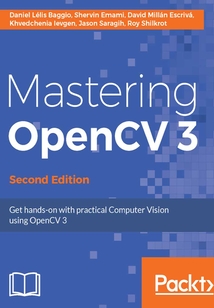首頁(yè) > 計(jì)算機(jī)網(wǎng)絡(luò) >
編程語(yǔ)言與程序設(shè)計(jì)
> Mastering OpenCV 3(Second Edition)最新章節(jié)目錄
舉報(bào) 

會(huì)員
Mastering OpenCV 3(Second Edition)
最新章節(jié):
References
ThisbookisforthosewhohaveabasicknowledgeofOpenCVandarecompetentC++programmers.Youneedtohaveanunderstandingofsomeofthemoretheoretical/mathematicalconcepts,aswemovequitequicklythroughoutthebook.
目錄(132章)
倒序
- 封面
- 版權(quán)信息
- Credits
- About the Authors
- About the Reviewer
- www.PacktPub.com
- Customer Feedback
- Preface
- What this book covers
- What you need for this book
- Who this book is for
- Conventions
- Reader feedback
- Customer support
- Downloading the example code
- Downloading the color images of this book
- Errata
- Piracy
- Questions
- Cartoonifier and Skin Changer for Raspberry Pi
- Accessing the webcam
- Main camera processing loop for a desktop app
- Generating a black and white sketch
- Generating a color painting and a cartoon
- Generating an evil mode using edge filters
- Generating an alien mode using skin detection
- Skin detection algorithm
- Showing the user where to put their face
- Implementation of the skin color changer
- Summary
- Exploring Structure from Motion Using OpenCV
- Structure from Motion concepts
- Estimating the camera motion from a pair of images
- Point matching using rich feature descriptors
- Finding camera matrices
- Choosing the image pair to use first
- Reconstructing the scene
- Reconstruction from many views
- Refinement of the reconstruction
- Using the example code
- Summary
- References
- Number Plate Recognition using SVM and Neural Network
- Introduction to ANPR
- ANPR algorithm
- Plate detection
- Segmentation
- Classification
- Plate recognition
- OCR segmentation
- Feature extraction
- OCR classification
- Evaluation
- Summary
- Non-Rigid Face Tracking
- Overview
- Utilities
- Object-oriented design
- Data collection - image and video annotation
- Training data types
- Annotation tool
- Pre-annotated data (the MUCT dataset)
- Geometrical constraints
- Procrustes analysis
- Linear shape models
- A combined local-global representation
- Training and visualization
- Facial feature detectors
- Correlation-based patch models
- Learning discriminative patch models
- Generative versus discriminative patch models
- Accounting for global geometric transformations
- Training and visualization
- Face detection and initialization
- Face tracking
- Face tracker implementation
- Training and visualization
- Generic versus person-specific models
- Summary
- References
- 3D Head Pose Estimation Using AAM and POSIT
- Active Appearance Models overview
- Active Shape Models
- Getting the feel of PCA
- Triangulation
- Triangle texture warping
- Model Instantiation - playing with the AAM
- AAM search and fitting
- POSIT
- Diving into POSIT
- POSIT and head model
- Tracking from webcam or video file
- Summary
- References
- Face Recognition Using Eigenfaces or Fisherfaces
- Introduction to face recognition and face detection
- Step 1 - face detection
- Implementing face detection using OpenCV
- Loading a Haar or LBP detector for object or face detection
- Accessing the webcam
- Detecting an object using the Haar or LBP Classifier
- Grayscale color conversion
- Shrinking the camera image
- Histogram equalization
- Detecting the face
- Step 2 - face preprocessing
- Eye detection
- Eye search regions
- Geometrical transformation
- Separate histogram equalization for left and right sides
- Smoothing
- Elliptical mask
- Step 3 - Collecting faces and learning from them
- Collecting preprocessed faces for training
- Training the face recognition system from collected faces
- Viewing the learned knowledge
- Average face
- Eigenvalues Eigenfaces and Fisherfaces
- Step 4 - face recognition
- Face identification - recognizing people from their face
- Face verification - validating that it is the claimed person
- Finishing touches - saving and loading files
- Finishing touches - making a nice and interactive GUI
- Drawing the GUI elements
- Startup mode
- Detection mode
- Collection mode
- Training mode
- Recognition mode
- Checking and handling mouse clicks
- Summary
- References 更新時(shí)間:2021-07-02 23:29:29
推薦閱讀
- JavaScript從入門到精通(微視頻精編版)
- Python測(cè)試開發(fā)入門與實(shí)踐
- Cassandra Data Modeling and Analysis
- SQL Server 2016數(shù)據(jù)庫(kù)應(yīng)用與開發(fā)習(xí)題解答與上機(jī)指導(dǎo)
- C語(yǔ)言程序設(shè)計(jì)案例精粹
- iOS編程基礎(chǔ):Swift、Xcode和Cocoa入門指南
- Bootstrap 4 Cookbook
- 編寫高質(zhì)量代碼:改善Objective-C程序的61個(gè)建議
- QGIS Python Programming Cookbook(Second Edition)
- Scala編程實(shí)戰(zhàn)
- Hands-On Robotics Programming with C++
- 金融商業(yè)數(shù)據(jù)分析:基于Python和SAS
- Python無(wú)監(jiān)督學(xué)習(xí)
- Java程序設(shè)計(jì)入門(第2版)
- Python Penetration Testing Essentials
- Appcelerator Titanium Smartphone App Development Cookbook
- VMware vRealize Orchestrator Essentials
- 微信公眾平臺(tái)服務(wù)號(hào)開發(fā):揭秘九大高級(jí)接口
- Python輕松學(xué):爬蟲、游戲與架站
- C語(yǔ)言程序設(shè)計(jì)
- C語(yǔ)言解惑
- ROS機(jī)器人程序設(shè)計(jì)
- Mastering PhoneGap Mobile Application Development
- Zabbix Cookbook
- Scala Test-Driven Development
- 高效C/C++調(diào)試
- Android Studio 2 Essentials(Second Edition)
- Magento Extensions Development
- JavaScript and JSON Essentials
- 前端程序員面試筆試寶典

